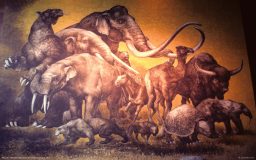
Science is a collection of stories we like to tell each other about how the world works. This one is a detective story- a murder mystery- with some unwitting miscreants, their multiple victims, and quiet heroes. The tale has been told before, with us-es, the human races, as the offender. We, the usual suspects, are framed as the Scapegoat in those fables. Other legends retell the coming of the Sky Monsters, different kinds of beings that go by different names. “Comet” is one of those names.
Hundreds of animal species famously died out during the last Ice Age. The reasons behind the Ice Age, Pleistocene, or Quaternary, megafaunal extinctions have been puzzled over for more than a century without any clear resolution. The problem has been called the ’Fermat’s Last Theorem of paleobiology’. These extinctions took place over thousands of years and around the world, but there was a strange specificity about which animals could stay and which had to go. There are two accredited narratives about what caused this, the human-hunting narrative and the climate-change narrative. Both, in curious ways, are wrong.
In a durable science story all the known pieces fit and work together. No part conflicts with any other part; no actor acts out of character. Nothing should have to be cut from whole cloth and entered into evidence without proof. This has been the problem with the stories of the passing of the giants on the earth in those days. All of these wonderful animals had sailed through the previous Ice Ages unscathed. What was different this time? If hominid hunters killed off this one species then why didn’t they kill off that other one, too? How could they possibly have exterminated any of them for that matter? Why did a colder climate kill animals that were better adapted for it than other animals that weren’t as well adapted, yet survived? The biggest animals should have had the best chance of surviving the cold, not the worst. If the sabertooth cat got sabertooth-cat disease, then why didn’t the mountain lion get mountain-lion disease? If the gardener crept in through the window, why didn’t the dog bark?
Certain motifs repeat throughout natural history, most of which I’ll have to leave out for brevity. One of course is inter-species warfare, another mass extinction. Another is a recurring theme in colonization: first the new life spreads out across the surface, there to ASCEND into the space above. But patterns are made and patterns can be broken and this pattern was broken in the instant case. Yet there was a peculiar order about the Pleistocene murders in time and place as well as in the types of victims chosen. As with any breed of serial killer, this striking structure gives us clues as to the modus operandi of the perpetrators, who were clearly very selective, very discriminating.
Many of the extinct animals were quite large, the biggest ever of their kind- beavers the size of bears, ‘armadillos’ as big as cars, giant kangaroos, the largest mammals of all time, the largest marsupials of all time. All of the lions, horses, and camels in the Americas died out. All of the hippos and rhinos in Eurasia died out along with giant eagles, ginormous lizards and tortoises, all kinds of different elephant-like animals, and so many more. For a sense of scale, the combined total mass of all of the different creatures that perished could be compared to the total mass of all the humans on Earth today, an Animal Armageddon.
The recent Ice Age extinction event was by far the worst, but it was not the first. There were several other Pleistocene Ice Ages before it, attended by the occasional dispatch of vigorous creatures: the stalking footfalls of an approaching murder monster, as if these wise guys were enrolled in some sort of demented wetwork apprenticeship. Working on their game. Getting their chops down. These earlier snuff jobs went by with little remark; the papers hardly covered them. Rub out a (Greco-Latin beast-name) here, liquidate a (something-Greek-something) there, and who’s to care, let alone file a police report? All of the other animals kept their mouths shut about it. They didn’t talk.
One standard of proof for murder is ’beyond a reasonable doubt’. These cases generally involve events taking place a few weeks or months in the past, with the police detective acting as an historian and a scientist of sorts. They often enough result in false convictions, just as have the Ice Age extinctions. For events taking place thousands or millions of years ago, long before we arrived on the scene with the proper forensic tools, we have to look at as many suspects as possible, no matter how innocent they might appear to be. Maybe the butler did it. We’ll have to investigate him of course, it’s de rigueur for the genre, but we mustn’t spoil the read by jumping to conclusions. Even if he had done it, he must have had accomplices for a job the size of this one.
In order to positively identify the guilty parties beyond a reasonable doubt, as well as the heroes, we will need to reach back a long, long way in time. As with any crime, we try to come to an understanding of the criminal’s means, their motive, and their opportunity in a given setting. We have to set the scene of the crime, look at the furniture around it, find out who the players are. For these particular suspects, their case history spans almost the entire record of life on Earth.
To be investigated further…
